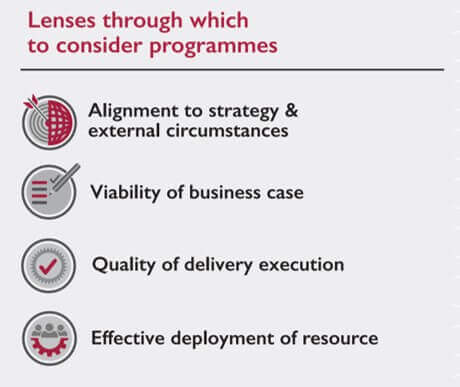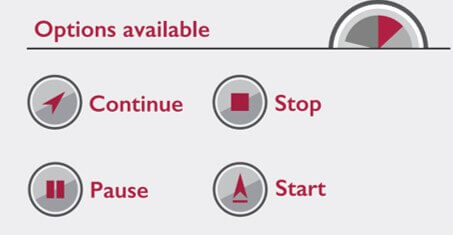Large business transformation programmes tend to come with a complex rationale and business case. When external circumstances change, these get challenged. Programme sponsors, programme managers, transformation directors and CFOs are each left with difficult decisions. Sunk costs, business expectations, and commitments made to senior executives and shareholders can make it challenging to reach the right conclusion in a short space of time.
Every so often, organisations therefore need to make the space to have a fact-based conversation which goes beyond day-to-day transformation delivery and extends into a more existential discussion: do we keep going, do we stop the programme altogether, or do we pause (if at all possible)? And by doing so, should we divert resources to new programmes that can better respond to the challenge of our new external circumstances?
Q. What is a black swan event?
A. A black swan event is one that is unexpected, has high impact and, though less relevant for our purposes here, can be rationalised as unsurprising in hindsight.
Black swan events like the Covid-19 pandemic made such inflection points more common, but outside of this immediate context, they have been and will always continue to be, a feature of all large, complex transformation initiatives. In such circumstances, how do you make the right decisions and, once you do, what happens next?
So how to assess my programmes?
Transformation programmes need to be assessed on their own merits with the support of experienced transformation professionals who have seen similar situations on multiple occasions. However, any such conversation is best had in a structured manner.

In this article, we help to do this by describing four options, their implications, and what the picture might look like in any given environment which would lead you to adopt them.
Notably, we haven’t included considerations of cash availability in our thinking – the cash position of enterprises will differ significantly over time and will usually play into these scenarios as an overriding driver, rather than form part of the picture for any one option.

Option 1: Continue - press on but adapt when you need to
Pursue this option where the fundamentals are not broken, even if other important areas still need to be addressed to ensure success”
We’d suggest pursuing this option where the strategic, business case or delivery execution fundamentals of the programme are not broken, even if other important areas still need to be addressed to ensure success. The programme remains essentially the right thing for the business.
Scope and timing can be adjusted, but the ‘how’ of the programme - the technology, process, organisation and data components – continue largely to be seen as the right means to the desired end, even if some delivery gaps may be apparent. Other areas may be struggling, such as resourcing, change management, and even execution delivery, but we find that these can be addressed in most cases whilst ensuring the business case remains healthy and activity overall remains in flight.
Press on with the programme, and in parallel attempt to fix the problems or respond to the change of circumstances leading to the inflection point. This could be accompanied by a resequencing and/or reduction of scope to reduce the pressure on the delivery team and free up resources such as cash, business SMEs, or release windows. Alternatively, an acceleration might be right. This comes into play if your programme’s strategic rationale is more pressing because of the changed circumstances, or if resources can now be freed from lower priority initiatives into your programme.
In a world where being seen to take decisive action is a mark of wisdom, the continue option can be seen as “too easy” a course of action to pursue. However, transformation is invariably a painful and complex undertaking accompanied by false steps. For experienced transformation professionals it is often as good as, to let challenges work themselves out than to manage the additional risk of upending the programme and all its team, with its attendant cost and business case impact.
We are working with a major retailer on a programme that will transform their core business processes. The business case remains strong and the outcomes will be a critical platform for future growth. Having objectively reassessed the situation, the justification for the programme remains as important as ever. We are now working with the client on innovative ways to increase delivery momentum.
Option 2: Stop - accept that programme is no longer viable
Sometimes it is essential to accept that circumstances have changed, that the programme is no longer the right thing to do, and that resources could be better deployed elsewhere"
Permanent stoppage of a large transformation programme can be a brave move. It is rightly or wrongly seen as an admission of mistakes being made which cannot be resolved. The likelihood is that a number of highly capable permanent resources will be bereft of roles and may need re-integration into the business.
Stoppage always requires significant management effort, and in the short term at least, this can more demanding than a “continue” option. This option will include reviewing and addressing all contractual commitments with a view to minimising financial exposure, whilst continuing to maintain valuable third party relationships where these relationships are not broken. In addition, the write-off cost of the investment made to date, especially if done during the latter stages of the programme, could run into many millions - eroding stakeholder confidence and potentially limiting any future investment into such programmes.
Unsurprisingly, this option suggests itself where the fundamentals around strategic alignment, business case strength or delivery execution quality have become increasingly open to challenge, or have been materially changed by new external circumstances.
The programme is now doing the wrong thing for the business (the ‘what’) and/or is doing it in in the wrong way (‘the how’). Poor execution may have persisted prior to the change of external circumstances, with confidence in the programme already being lost or the business case now being untenable. As a result, there is no realistic alternative but to stop the project in its current form. In clients with strong governance mechanisms, we would normally expect such scenarios to be rare in normal times. However, even for the best governed and run programmes, what may have been correct at the time of inception, may not continue to be so over time.
A client of ours had previously attempted to deliver a global SAP transformation programme with a complex target architecture and ambitious deployment schedule. After the first country deployment it became clear that the solution was going to put the business operations at unacceptable levels of risk. Stopping the programme was the right thing to do, as the strategic rationale of the programme required a fundamental rethink.
Option 3: Pause - take time to fix issues or respond to changed circumstances
A pause buys you time and space, but usually comes with a degree of ongoing spend. A well-executed pause can sow the seeds for future success”
Arguably the decision to pause is the bravest decision of all, as this still requires a (sometimes significant) degree of ongoing spend - with no guarantee of a successful result at the end. The counter to this is that your programme would not be able to adequately respond to the change in circumstances without a pause. It gives your organisation breathing space to succeed.
During a pause resources and the energy of the team can be focused on responding and identifying a way forward, freed from the intensity of daily delivery. This could still require a large part of the team to remain mobilised, or there could be a partial redeployment/stand down of resources (commercials permitting).
A pause is a good option for a programme which is fundamentally sound and which has a business case with reasonable tolerance for variances in costs and benefits delivery.
There may be major scope changes needed to respond to new external circumstances, or significant shortcomings to resolve (such as solution gaps for which there appears to be no easy answer), or areas where delivery has fallen behind plan. All of these scenarios would require a re-plan of such scale that there would almost be no choice but to divert resource from delivery. A change of supplier driven by a persistent failure to perform would also typically lead to a pause.
Where a pause differs from a stop is an agreed understanding that the programme remains sufficiently compelling that it will indeed be picked up again.
Pauses should be tightly governed, with clear exit criteria and a process for further decision making defined before the programme is un-paused. It is important to have a clear plan, even for long pause periods, including how the re-mobilisation will happen. Otherwise there is a risk of losing all momentum which may be hard to regain.
On-going communication with the stood-down programme team and suppliers will help maintain buy-in and make the eventual re-mobilisation easier. The fundamental objective of the pause governance is to ensure that the programme is in a stronger position once it restarts.
A client of ours, a global oil company, was deploying an ERP solution to its downstream supply chain – only to see a drastic decrease in the product demand and supply chain activity resulting in temporary business priority changes due to Covid-19.
The programme was fundamentally sound but external circumstances warranted a pause.
Option 4: Start - deploy resources on a new initiative
A change of circumstances can open up new opportunities where your resources can be better utilised”
In amongst the turmoil of some of their programmes stopping or pausing, we are seeing clients start new initiatives which are now of greater strategic or financial benefit to their organisation.
There are many examples of new transformation programmes being mobilised in response to the changed external circumstances. During the Covid-19 pandemic, pharmaceutical firms established new commercial tie ups on product development, media distribution companies bypassed cinema and went direct to paid home subscription streaming, and firms that were traditionally wholesalers entered the retail market.
Clients should consider if there are better ways in which resources freed up from programmes can be used. Are there new (perhaps yet undocumented) opportunities which could be brought to life with an injection of additional, highly skilled resources? Or are there other programmes with lower risk and/or more compelling business cases which would benefit from the provision of additional resource to bolster the team or to backfill more expensive, external delivery resources?
The demand for rapid scoping, shaping and delivery of business change will remain, and in many cases will become increasingly important. The organisations that succeed are those that can rapidly reallocate human, financial and technological resources around their change portfolios in response.
A global FMCG client of ours has seen a big shift towards eCommerce buying channels due to the pandemic, some of which they expect to be sustained once the crisis is over. To leverage this trend, we supported them with an eCommerce Content Strategy piece of work, to help them understand what the future of great content (text, images, video, etc.) and on-line experience looked like and how they could best produce, deploy and optimise that content to drive their eCommerce growth.
Conclusions
Making decisions about the fate of major programmes is always difficult, given the cost and complexity involved. However, and especially in the most challenging of times, using a structured, objective framework to support these decisions can turn a highly emotive situation into a well-considered and defendable process. As a result, you are more likely to make the right choice rather than jump to a decision that you may later regret.











